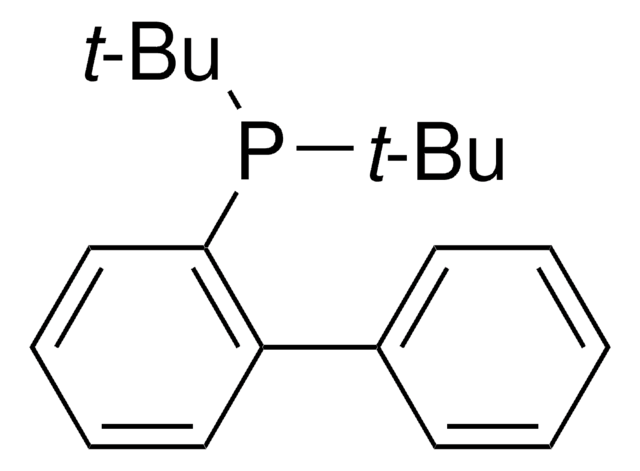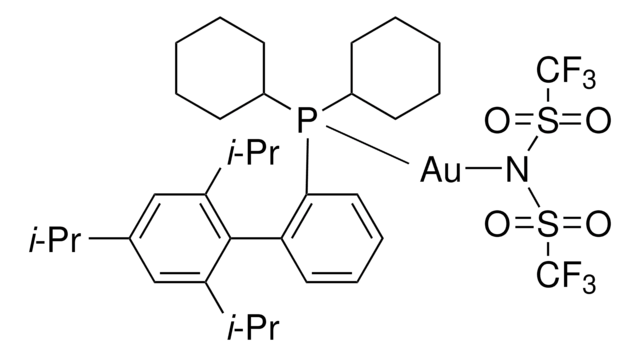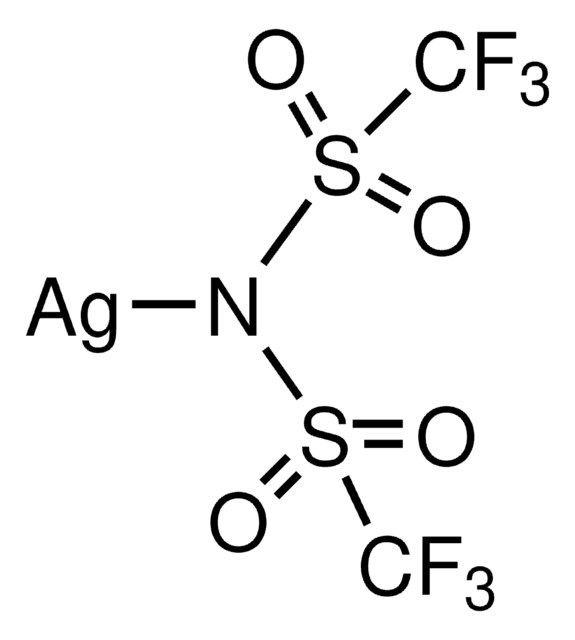697575
(Acetonitrile)[(2-biphenyl)di-tert-butylphosphine]gold(I) hexafluoroantimonate
Synonym(s):
JohnPhos Au(MeCN)SbF6
About This Item
Recommended Products
form
solid
Quality Level
reaction suitability
core: gold
reagent type: catalyst
mp
198-203 °C (D)
SMILES string
[Au+].CC#N.F[Sb-](F)(F)(F)(F)F.CC(C)(C)P(c1ccccc1-c2ccccc2)C(C)(C)C
InChI
1S/C20H27P.C2H3N.Au.6FH.Sb/c1-19(2,3)21(20(4,5)6)18-15-11-10-14-17(18)16-12-8-7-9-13-16;1-2-3;;;;;;;;/h7-15H,1-6H3;1H3;;6*1H;/q;;+1;;;;;;;+5/p-6
InChI key
ADQOZROJMVWPRI-UHFFFAOYSA-H
General description
Application
Signal Word
Warning
Hazard Statements
Precautionary Statements
Hazard Classifications
Acute Tox. 4 Inhalation - Acute Tox. 4 Oral - Aquatic Chronic 2
Storage Class Code
11 - Combustible Solids
WGK
WGK 3
Flash Point(F)
Not applicable
Flash Point(C)
Not applicable
Choose from one of the most recent versions:
Certificates of Analysis (COA)
Don't see the Right Version?
If you require a particular version, you can look up a specific certificate by the Lot or Batch number.
Already Own This Product?
Find documentation for the products that you have recently purchased in the Document Library.
Articles
Access gold precatalysts, silver salts, and unsaturated building blocks to accelerate research success in catalysis applications.
Related Content
The research of the Echavarren group centers on the development of new reactions based on the use of electrophilic complexes of Au(I), Pt(II), and other transition metals as catalysts and their applications in organic synthesis of complex, biologically active molecules. The Echavarren group is also examining new strategies for the synthesis of polyarenes of interest in material science. In particular, they are interested in the ready construction of C-60 skeletons using reactions catalyzed by Pd(0) and other transition metals.
Our team of scientists has experience in all areas of research including Life Science, Material Science, Chemical Synthesis, Chromatography, Analytical and many others.
Contact Technical Service![Chloro[(1,1′-biphenyl-2-yl)di-tert-butylphosphine]gold(I) 98%](/deepweb/assets/sigmaaldrich/product/structures/192/300/6b6ed2fd-ac0b-4370-80e3-807dad65a825/640/6b6ed2fd-ac0b-4370-80e3-807dad65a825.png)
![[(IPr)AuCl] Umicore](/deepweb/assets/sigmaaldrich/product/structures/186/572/1f89dfca-fb52-46a2-9c9d-96db67c22883/640/1f89dfca-fb52-46a2-9c9d-96db67c22883.png)

![Chloro[2-dicyclohexyl(2′,4′,6′-trisopropylbiphenyl)phosphine]gold(I)](/deepweb/assets/sigmaaldrich/product/structures/253/590/7ea3a0c9-1b4c-4e68-8fa0-5e764f73519a/640/7ea3a0c9-1b4c-4e68-8fa0-5e764f73519a.png)


gold(I) (2:1) toluene adduct](/deepweb/assets/sigmaaldrich/product/structures/104/897/81ee3e56-c988-4d0f-9614-1269b470316d/640/81ee3e56-c988-4d0f-9614-1269b470316d.png)
![Poly[2-methoxy-5-(2-ethylhexyloxy)-1,4-phenylenevinylene] average Mn 40,000-70,000](/deepweb/assets/sigmaaldrich/product/structures/344/488/b8f8179d-3970-4deb-a754-adda88cdb36f/640/b8f8179d-3970-4deb-a754-adda88cdb36f.png)



